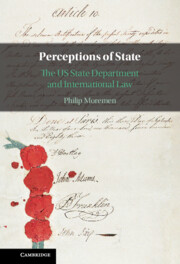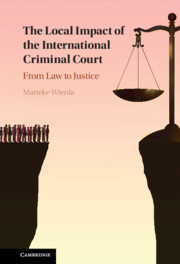135 results
Healthcare Staff Perceptions of the Hospital Food Environment: A Narrative Systematic Review
-
- Journal:
- Public Health Nutrition / Accepted manuscript
- Published online by Cambridge University Press:
- 20 March 2025, pp. 1-27
-
- Article
-
- You have access
- Open access
- Export citation
Exploring palliative and end-of-life care perspectives and lived experiences among generations of African migrants residing outside the continent: A scoping review
-
- Journal:
- Palliative & Supportive Care / Volume 23 / 2025
- Published online by Cambridge University Press:
- 28 February 2025, e71
-
- Article
-
- You have access
- Open access
- HTML
- Export citation
Integrating collaborative digital multimodal tasks in Spanish as a second language course
-
- Journal:
- ReCALL , First View
- Published online by Cambridge University Press:
- 19 February 2025, pp. 1-17
-
- Article
-
- You have access
- Open access
- HTML
- Export citation

Perceptions of State
- The US State Department and International Law
-
- Published online:
- 07 June 2024
- Print publication:
- 27 June 2024
Perceptions of Healthcare Workers on the Attributes of the Integrated Disease Surveillance and Response System in Zimbabwe
-
- Journal:
- Disaster Medicine and Public Health Preparedness / Volume 18 / 2024
- Published online by Cambridge University Press:
- 16 May 2024, e262
-
- Article
-
- You have access
- HTML
- Export citation
Parents’ perceptions of the Tasmanian School Lunch Project - interim findings
-
- Journal:
- Proceedings of the Nutrition Society / Volume 83 / Issue OCE1 / April 2024
- Published online by Cambridge University Press:
- 07 May 2024, E27
-
- Article
-
- You have access
- Export citation
Knowledge, perceptions and practices towards diabetes risk in sub-Saharan Africa: a mixed-methods scoping review
-
- Journal:
- Public Health Nutrition / Volume 27 / Issue 1 / 2024
- Published online by Cambridge University Press:
- 27 March 2024, e104
-
- Article
-
- You have access
- Open access
- HTML
- Export citation
7 - Operationalising Distinction in South Sudan
-
-
- Book:
- Civility, Barbarism and the Evolution of International Humanitarian Law
- Published online:
- 11 January 2024
- Print publication:
- 01 February 2024, pp 135-155
-
- Chapter
- Export citation
Perceptions, barriers and enablers on salt reduction in the out-of-home sectors in Malaysia (MySaltOH) from the perspective of street food vendors, caterers and consumers
-
- Journal:
- Public Health Nutrition / Volume 27 / Issue 1 / 2024
- Published online by Cambridge University Press:
- 15 December 2023, e12
-
- Article
-
- You have access
- Open access
- HTML
- Export citation
Examining How Young Adults Perceive, Understand, and Respond to SARS-CoV-2 Variants in Canada and France: Implications for Public Health Preparedness Efforts
-
- Journal:
- Disaster Medicine and Public Health Preparedness / Volume 17 / 2023
- Published online by Cambridge University Press:
- 24 August 2023, e462
-
- Article
-
- You have access
- Open access
- HTML
- Export citation
4 - Can L2 Learners Imagine Advancedness?
- from Part I - Advancedness and the L2 Learner
-
- Book:
- Second Language Identity
- Published online:
- 27 July 2023
- Print publication:
- 10 August 2023, pp 62-90
-
- Chapter
- Export citation
7 - A Qualitative Analysis of Language Professionals’ Descriptions of Their Ideology and Assessment of Advanced L2 Spanish
- from Part II - Variable Notions of Advancedness
-
- Book:
- Second Language Identity
- Published online:
- 27 July 2023
- Print publication:
- 10 August 2023, pp 138-168
-
- Chapter
- Export citation
Introduction
-
- Book:
- The Local Impact of the International Criminal Court
- Published online:
- 06 July 2023
- Print publication:
- 20 July 2023, pp 1-8
-
- Chapter
- Export citation
7 - Societal Impact II
-
- Book:
- The Local Impact of the International Criminal Court
- Published online:
- 06 July 2023
- Print publication:
- 20 July 2023, pp 217-260
-
- Chapter
- Export citation
Postscript
-
- Book:
- The Local Impact of the International Criminal Court
- Published online:
- 06 July 2023
- Print publication:
- 20 July 2023, pp 282-284
-
- Chapter
- Export citation

The Local Impact of the International Criminal Court
- From Law to Justice
-
- Published online:
- 06 July 2023
- Print publication:
- 20 July 2023
Success Semantics, Reinforcing Satisfaction, and Sensory Inclinations
-
- Journal:
- Dialogue: Canadian Philosophical Review / Revue canadienne de philosophie / Volume 63 / Issue 3 / December 2024
- Published online by Cambridge University Press:
- 04 July 2023, pp. 575-586
-
- Article
-
- You have access
- Open access
- HTML
- Export citation
Community perceptions of environmental water: a review
-
- Journal:
- Environmental Conservation / Volume 50 / Issue 2 / June 2023
- Published online by Cambridge University Press:
- 27 March 2023, pp. 73-82
-
- Article
-
- You have access
- Open access
- HTML
- Export citation
‘Some of my patients only come to renew their prescriptions. They are not interested in any additional advice or support’. Physicians’ perceptions on their roles in cardiovascular diseases risk reduction and management in Fiji
-
- Journal:
- Primary Health Care Research & Development / Volume 24 / 2023
- Published online by Cambridge University Press:
- 08 February 2023, e11
-
- Article
-
- You have access
- Open access
- HTML
- Export citation


